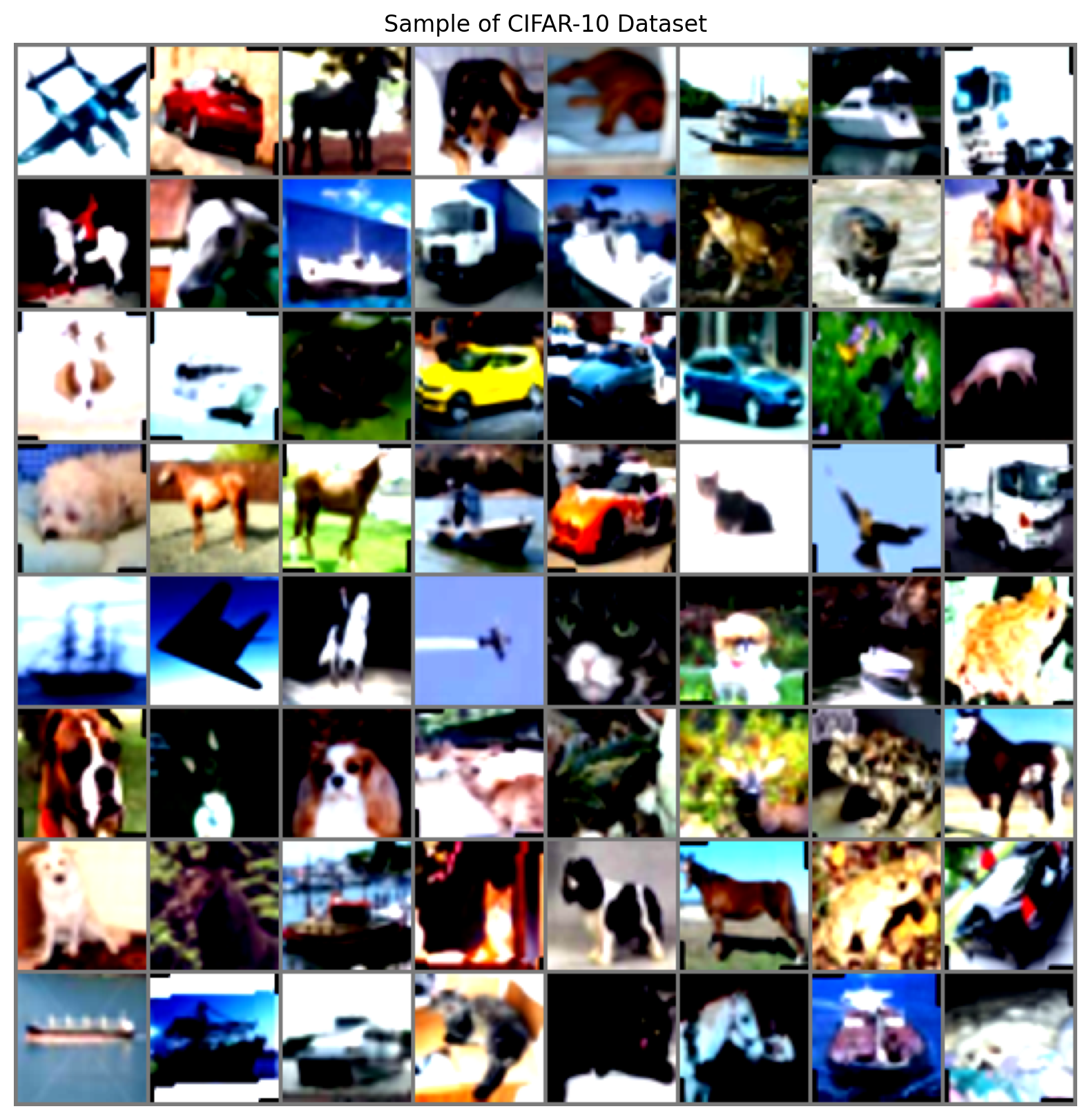CNN Applications#
import torch
import torch.nn as nn
import torch.nn.functional as F
import torch.optim as optim
import torchvision
import torchvision.transforms as transforms
from torch.utils.data import DataLoader, Dataset
from tqdm import tqdm
import numpy as np
%matplotlib inline
%config InlineBackend.figure_format = 'retina'
import matplotlib.pyplot as plt
Example of Simple CNN with Image Augmentation#
# Define image augmentation and normalization for training
transform_train = transforms.Compose([
transforms.RandomRotation(5),
transforms.RandomHorizontalFlip(),
transforms.Resize((64,64)),
transforms.ToTensor(),
transforms.Normalize((0.4914, 0.4822, 0.4465), (0.2023, 0.1994, 0.2010)),
])
# Define normalization for testing
transform_test = transforms.Compose([
transforms.ToTensor(),
transforms.Normalize((0.4914, 0.4822, 0.4465), (0.2023, 0.1994, 0.2010)),
])
# Load the CIFAR-10 dataset
trainset = torchvision.datasets.CIFAR10(root='./data', train=True, download=True, transform=transform_train)
trainloader = torch.utils.data.DataLoader(trainset, batch_size=64, shuffle=True, num_workers=2)
testset = torchvision.datasets.CIFAR10(root='./data', train=False, download=True, transform=transform_test)
testloader = torch.utils.data.DataLoader(testset, shuffle=False, num_workers=2)
classes = ('plane', 'car', 'bird', 'cat', 'deer', 'dog', 'frog', 'horse', 'ship', 'truck')
Files already downloaded and verified
Files already downloaded and verified
# Function to display images
def imshow(img, label):
img = img / 2 + 0.48 # unnormalize
npimg = img.numpy()
plt.figure(figsize=(10, 10))
plt.imshow(np.transpose(np.clip(npimg,0,1), (1, 2, 0)))
plt.title('Sample of CIFAR-10 Dataset')
plt.axis('off')
#plt.title(f'First Item: {class_names[label]}')
plt.show()
# Get some random training images
dataiter = iter(trainloader)
images, labels = next(dataiter)
# Show images
imshow(torchvision.utils.make_grid(images), labels[0])
# Display the name of the label for the first image in the batch
print(f'First Label: {classes[labels[0]]}')
class SimpleCNN(nn.Module):
def __init__(self):
super(SimpleCNN, self).__init__()
self.conv1 = nn.Conv2d(3, 40, kernel_size=3, padding=1)
self.conv2 = nn.Conv2d(40, 80, kernel_size=3, padding=1)
self.pool = nn.MaxPool2d(kernel_size=2, stride=2, padding=0)
self.fc1 = nn.Linear(80 * 8 * 8, 1000)
self.fc2 = nn.Linear(1000, 10)
self.dropout = nn.Dropout(0.25)
def forward(self, x):
x = self.pool(F.silu(self.conv1(x)))
x = self.pool(F.silu(self.conv2(x)))
x = x.view(-1, 80 * 8 * 8)
x = F.relu(self.fc1(x))
x = self.dropout(x)
x = self.fc2(x)
return x
net = SimpleCNN()
criterion = nn.CrossEntropyLoss()
optimizer = optim.Adam(net.parameters(), lr=0.001)
---------------------------------------------------------------------------
NameError Traceback (most recent call last)
<ipython-input-3-b182c23cf2a6> in <cell line: 2>()
1 criterion = nn.CrossEntropyLoss()
----> 2 optimizer = optim.Adam(net.parameters(), lr=0.001)
NameError: name 'net' is not defined
# Function to calculate accuracy
def calculate_accuracy(loader, model):
correct = 0
total = 0
model.eval() # Set the model to evaluation mode
with torch.no_grad():
for data in loader:
images, labels = data
outputs = model(images)
_, predicted = torch.max(outputs.data, 1)
total += labels.size(0)
correct += (predicted == labels).sum().item()
model.train() # Set the model back to training mode
return 100 * correct / total
num_epochs = 1
for epoch in range(num_epochs): # Loop over the dataset multiple times
running_loss = 0.0
train_accuracy = 0.0
test_accuracy = 0.0
with tqdm(total=len(trainloader), desc=f'Epoch {epoch + 1}/{num_epochs}', unit='batch') as pbar:
for i, data in enumerate(trainloader, 0):
inputs, labels = data
# Zero the parameter gradients
optimizer.zero_grad()
# Forward pass
outputs = net(inputs)
# Compute loss
loss = criterion(outputs, labels)
# Backward pass
loss.backward()
# Update weights
optimizer.step()
# Accumulate running loss
running_loss += loss.item()
pbar.set_postfix(loss=running_loss / (i + 1))
pbar.update(1)
# Calculate accuracies
train_accuracy = calculate_accuracy(trainloader, net)
test_accuracy = calculate_accuracy(testloader, net)
# Print statistics
print(f'Epoch {epoch + 1}/{num_epochs}, Loss: {running_loss / len(trainloader):.3f}, '
f'Train Accuracy: {train_accuracy:.2f}%, Test Accuracy: {test_accuracy:.2f}%')
print('Finished Training')
Epoch 1/1: 100%|██████████| 782/782 [01:16<00:00, 10.18batch/s, loss=1.21]
Epoch 1/1, Loss: 1.207, Train Accuracy: 67.07%, Test Accuracy: 66.42%
Finished Training
correct = 0
total = 0
with torch.no_grad():
for data in testloader:
images, labels = data
net.eval()
outputs = net(images)
_, predicted = torch.max(outputs.data, 1)
total += labels.size(0)
correct += (predicted == labels).sum().item()
print(f'Accuracy of the network on the 10000 test images: {100 * correct / total:.2f}%')
Accuracy of the network on the 10000 test images: 77.52%
Example with AlexNet#
# Define image augmentation and normalization for training
transform_train = transforms.Compose([
transforms.RandomRotation(5),
transforms.RandomHorizontalFlip(),
transforms.Resize((227,227)),
transforms.ToTensor(),
transforms.Normalize((0.4914, 0.4822, 0.4465), (0.2023, 0.1994, 0.2010)),
])
# Define normalization for testing
transform_test = transforms.Compose([
transforms.Resize((227,227)),
transforms.ToTensor(),
transforms.Normalize((0.4914, 0.4822, 0.4465), (0.2023, 0.1994, 0.2010)),
])
# Load the CIFAR-10 dataset
trainset = torchvision.datasets.CIFAR10(root='./data', train=True, download=True, transform=transform_train)
trainloader = torch.utils.data.DataLoader(trainset, batch_size=32, shuffle=True, num_workers=2)
testset = torchvision.datasets.CIFAR10(root='./data', train=False, download=True, transform=transform_test)
testloader = torch.utils.data.DataLoader(testset, shuffle=False, num_workers=2)
classes = ('plane', 'car', 'bird', 'cat', 'deer', 'dog', 'frog', 'horse', 'ship', 'truck')
Files already downloaded and verified
Files already downloaded and verified
class AlexNet(nn.Module):
def __init__(self, num_classes=10):
super(AlexNet, self).__init__()
self.layer1 = nn.Sequential(
nn.Conv2d(3, 96, kernel_size=11, stride=4, padding=0),
nn.BatchNorm2d(96),
nn.ReLU(),
nn.MaxPool2d(kernel_size = 3, stride = 2))
self.layer2 = nn.Sequential(
nn.Conv2d(96, 256, kernel_size=5, stride=1, padding=2),
nn.BatchNorm2d(256),
nn.ReLU(),
nn.MaxPool2d(kernel_size = 3, stride = 2))
self.layer3 = nn.Sequential(
nn.Conv2d(256, 384, kernel_size=3, stride=1, padding=1),
nn.BatchNorm2d(384),
nn.ReLU())
self.layer4 = nn.Sequential(
nn.Conv2d(384, 384, kernel_size=3, stride=1, padding=1),
nn.BatchNorm2d(384),
nn.ReLU())
self.layer5 = nn.Sequential(
nn.Conv2d(384, 256, kernel_size=3, stride=1, padding=1),
nn.BatchNorm2d(256),
nn.ReLU(),
nn.MaxPool2d(kernel_size = 3, stride = 2))
self.fc = nn.Sequential(
nn.Dropout(0.5),
nn.Linear(9216, 4096),
nn.ReLU())
self.fc1 = nn.Sequential(
nn.Dropout(0.5),
nn.Linear(4096, 4096),
nn.ReLU())
self.fc2= nn.Sequential(
nn.Linear(4096, num_classes))
def forward(self, x):
out = self.layer1(x)
out = self.layer2(out)
out = self.layer3(out)
out = self.layer4(out)
out = self.layer5(out)
out = out.reshape(out.size(0), -1)
out = self.fc(out)
out = self.fc1(out)
out = self.fc2(out)
return out
num_classes = 10
net = AlexNet(num_classes)
criterion = nn.CrossEntropyLoss()
optimizer = optim.Adam(net.parameters(), lr=0.001)
num_epochs = 10
for epoch in range(num_epochs): # Loop over the dataset multiple times
running_loss = 0.0
train_accuracy = 0.0
test_accuracy = 0.0
with tqdm(total=len(trainloader), desc=f'Epoch {epoch + 1}/{num_epochs}', unit='batch') as pbar:
for i, data in enumerate(trainloader, 0):
inputs, labels = data
# Zero the parameter gradients
optimizer.zero_grad()
# Forward pass
outputs = net(inputs)
# Compute loss
loss = criterion(outputs, labels)
# Backward pass
loss.backward()
# Update weights
optimizer.step()
# Accumulate running loss
running_loss += loss.item()
pbar.set_postfix(loss=running_loss / (i + 1))
pbar.update(1)
# Calculate accuracies
train_accuracy = calculate_accuracy(trainloader, net)
test_accuracy = calculate_accuracy(testloader, net)
# Print statistics
print(f'Epoch {epoch + 1}/{num_epochs}, Loss: {running_loss / len(trainloader):.3f}, '
f'Train Accuracy: {train_accuracy:.2f}%, Test Accuracy: {test_accuracy:.2f}%')
print('Finished Training')
Example with Dense Net design#

Main Idea#
Dense Blocks: The core component of DenseNet is the dense block. Within each dense block, each layer receives the feature maps from all preceding layers as inputs, and passes its own feature maps to all subsequent layers. This results in a dense connectivity pattern.
Bottleneck Layers: To improve computational efficiency, DenseNet uses bottleneck layers (1x1 convolutions) within the dense blocks. These layers reduce the number of input feature maps before passing them through 3x3 convolutions.
Transition Layers: Between dense blocks, transition layers are used to reduce the size of feature maps and the number of feature maps. These layers consist of a batch normalization layer, a 1x1 convolutional layer, and a 2x2 average pooling layer.
Growth Rate: The growth rate (k) is a hyperparameter that refers to the number of output feature maps each layer in a dense block produces. For DenseNet-121, the growth rate is typically 32.
Architecture of DenseNet-121#
DenseNet-121 consists of:
An initial convolutional layer
Four dense blocks
Three transition layers between the dense blocks
A classification layer at the end
Here’s a breakdown of the architecture:
Initial Convolution:
7x7 Convolution with stride 2
Batch Normalization
ReLU activation
3x3 Max Pooling with stride 2
Dense Block 1:
6 layers, each with bottleneck (1x1 convolution) and 3x3 convolution
Transition Layer 1:
Batch Normalization
1x1 Convolution
2x2 Average Pooling with stride 2
Dense Block 2:
12 layers, each with bottleneck (1x1 convolution) and 3x3 convolution
Transition Layer 2:
Batch Normalization
1x1 Convolution
2x2 Average Pooling with stride 2
Dense Block 3:
24 layers, each with bottleneck (1x1 convolution) and 3x3 convolution
Transition Layer 3:
Batch Normalization
1x1 Convolution
2x2 Average Pooling with stride 2
Dense Block 4:
16 layers, each with bottleneck (1x1 convolution) and 3x3 convolution
Classification Layer:
Batch Normalization
ReLU activation
Global Average Pooling
Fully Connected Layer (output size depends on the number of classes, typically 1000 for ImageNet)
Summary of Layers#
Convolutional Layer (7x7): 1 layer
Dense Blocks: 4 blocks (6 layers, 12 layers, 24 layers, 16 layers)
Transition Layers: 3 layers
Classification Layer: 1 layer
Visualization of DenseNet-121#
Input Image
|
7x7 Conv, Stride 2
|
3x3 Max Pool, Stride 2
|
Dense Block 1
|
Transition Layer 1
|
Dense Block 2
|
Transition Layer 2
|
Dense Block 3
|
Transition Layer 3
|
Dense Block 4
|
Global Average Pool
|
Fully Connected (Softmax)
|
Output (Class Probabilities)
DenseNet-121’s design ensures that each layer has direct access to the gradients from the loss function and the original input signal, which improves gradient flow and efficiency of parameter usage, ultimately leading to better performance and robustness in training deep neural networks.

# CIFAR-10 dataset
train_dataset = torchvision.datasets.CIFAR10(root='./data', train=True, download=True)
test_dataset = torchvision.datasets.CIFAR10(root='./data', train=False, download=True)
CLASS_NAMES = ['airplane', 'automobile', 'bird', 'cat', 'deer', 'dog', 'frog', 'horse', 'ship', 'truck']
# Split train dataset into train and validation
validation_split = 0.1
num_train = len(train_dataset)
indices = list(range(num_train))
split = int(np.floor(validation_split * num_train))
np.random.seed(42)
np.random.shuffle(indices)
train_idx, val_idx = indices[split:], indices[:split]
# Define transformations
transform_train = transforms.Compose([
transforms.RandomCrop(32, padding=4),
transforms.RandomHorizontalFlip(),
transforms.Resize((224, 224)), # Resize to 224x224 for DenseNet
transforms.ToTensor(),
transforms.Normalize((0.4914, 0.4822, 0.4465), (0.2023, 0.1994, 0.2010)),
])
transform_test = transforms.Compose([
transforms.Resize((224, 224)), # Resize to 224x224 for DenseNet
transforms.ToTensor(),
transforms.Normalize((0.4914, 0.4822, 0.4465), (0.2023, 0.1994, 0.2010)),
])
# Custom Dataset class to apply transformations
class CIFAR10Dataset(Dataset):
def __init__(self, dataset, indices, transform=None):
self.dataset = dataset
self.indices = indices
self.transform = transform
def __len__(self):
return len(self.indices)
def __getitem__(self, idx):
image, label = self.dataset[self.indices[idx]]
if self.transform:
image = self.transform(image)
return image, label
train_dataset = CIFAR10Dataset(train_dataset, train_idx, transform=transform_train)
val_dataset = CIFAR10Dataset(torchvision.datasets.CIFAR10(root='./data', train=True, download=True), val_idx, transform=transform_test)
test_dataset = CIFAR10Dataset(test_dataset, list(range(len(test_dataset))), transform=transform_test)
train_loader = DataLoader(train_dataset, batch_size=32, shuffle=True, num_workers=2)
val_loader = DataLoader(val_dataset, batch_size=32, shuffle=False, num_workers=2)
test_loader = DataLoader(test_dataset, batch_size=32, shuffle=False, num_workers=2)
Files already downloaded and verified
Files already downloaded and verified
Files already downloaded and verified
from torchvision.models import densenet121
# Load pre-trained DenseNet121 and modify it for CIFAR-10
model = densenet121(pretrained=True)
# Replace the classifier
num_ftrs = model.classifier.in_features
model.classifier = nn.Sequential(
nn.Linear(num_ftrs, 1024),
nn.ReLU(),
nn.Linear(1024, 10)
)
device = torch.device("cuda" if torch.cuda.is_available() else "cpu")
model = model.to(device)
# Freeze all layers initially
for param in model.parameters():
param.requires_grad = False
# Unfreeze the classifier layers
for param in model.classifier.parameters():
param.requires_grad = True
criterion = nn.CrossEntropyLoss()
optimizer = optim.Adam(model.classifier.parameters(), lr=0.001)
def train_model(model, criterion, optimizer, train_loader, val_loader, num_epochs=10):
for epoch in range(num_epochs):
model.train()
running_loss = 0.0
for inputs, labels in train_loader:
inputs, labels = inputs.to(device), labels.to(device)
optimizer.zero_grad()
outputs = model(inputs)
loss = criterion(outputs, labels)
loss.backward()
optimizer.step()
running_loss += loss.item()
print(f'Epoch [{epoch+1}/{num_epochs}], Loss: {running_loss/len(train_loader):.4f}')
validate_model(model, val_loader)
def validate_model(model, val_loader):
model.eval()
correct = 0
total = 0
with torch.no_grad():
for inputs, labels in val_loader:
inputs, labels = inputs.to(device), labels.to(device)
outputs = model(inputs)
_, predicted = torch.max(outputs.data, 1)
total += labels.size(0)
correct += (predicted == labels).sum().item()
print(f'Validation Accuracy: {100 * correct / total:.2f}%')
train_model(model, criterion, optimizer, train_loader, val_loader, num_epochs=10)
# Unfreeze all layers for fine-tuning
for param in model.parameters():
param.requires_grad = True
optimizer = optim.SGD(model.parameters(), lr=0.0001, momentum=0.9)
train_model(model, criterion, optimizer, train_loader, val_loader, num_epochs=20)
def test_model(model, test_loader):
model.eval()
correct = 0
total = 0
with torch.no_grad():
for inputs, labels in test_loader:
inputs, labels = inputs.to(device), labels.to(device)
outputs = model(inputs)
_, predicted = torch.max(outputs.data, 1)
total += labels.size(0)
correct += (predicted == labels).sum().item()
print(f'Test Accuracy: {100 * correct / total:.2f}%')
test_model(model, test_loader)
Epoch [1/10], Loss: 0.8287
Validation Accuracy: 78.60%
Epoch [2/10], Loss: 0.7081
Validation Accuracy: 80.72%
Epoch [3/10], Loss: 0.6709
Validation Accuracy: 81.18%
Epoch [4/10], Loss: 0.6391
Validation Accuracy: 80.90%
Epoch [5/10], Loss: 0.6172
Validation Accuracy: 82.90%
Epoch [6/10], Loss: 0.5991
Validation Accuracy: 82.48%
Epoch [7/10], Loss: 0.5815
Validation Accuracy: 82.78%
Epoch [8/10], Loss: 0.5780
Validation Accuracy: 82.80%
Epoch [9/10], Loss: 0.5616
Validation Accuracy: 82.44%
Epoch [10/10], Loss: 0.5620
Validation Accuracy: 82.90%
Epoch [1/20], Loss: 0.3187
Validation Accuracy: 92.54%
Epoch [2/20], Loss: 0.2062
Validation Accuracy: 93.88%
Epoch [3/20], Loss: 0.1641
Validation Accuracy: 94.46%
Epoch [4/20], Loss: 0.1389
Validation Accuracy: 95.08%
Epoch [5/20], Loss: 0.1220
Validation Accuracy: 95.42%
Epoch [6/20], Loss: 0.1099
Validation Accuracy: 95.50%
Epoch [7/20], Loss: 0.0964
Validation Accuracy: 95.92%
Epoch [8/20], Loss: 0.0880
Validation Accuracy: 96.02%
Epoch [9/20], Loss: 0.0803
Validation Accuracy: 96.24%
Epoch [10/20], Loss: 0.0718
Validation Accuracy: 96.42%
Epoch [11/20], Loss: 0.0675
Validation Accuracy: 96.20%
Epoch [12/20], Loss: 0.0604
Validation Accuracy: 96.48%
Epoch [13/20], Loss: 0.0558
Validation Accuracy: 96.42%
Epoch [14/20], Loss: 0.0522
Validation Accuracy: 96.42%
Epoch [15/20], Loss: 0.0474
Validation Accuracy: 96.32%
Epoch [16/20], Loss: 0.0431
Validation Accuracy: 96.48%
Epoch [17/20], Loss: 0.0395
Validation Accuracy: 96.42%
Epoch [18/20], Loss: 0.0370
Validation Accuracy: 96.58%
Epoch [19/20], Loss: 0.0336
Validation Accuracy: 96.66%
Epoch [20/20], Loss: 0.0344
Validation Accuracy: 96.48%
Test Accuracy: 96.50%



